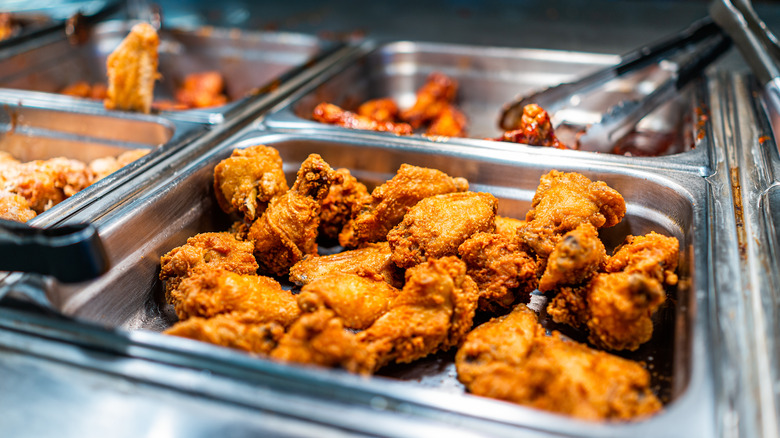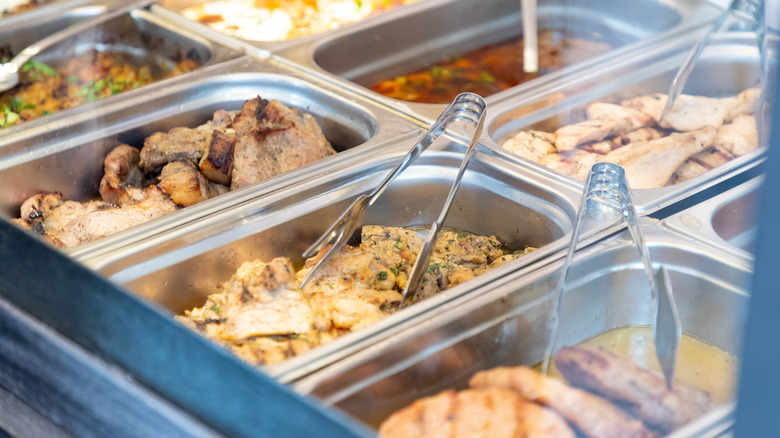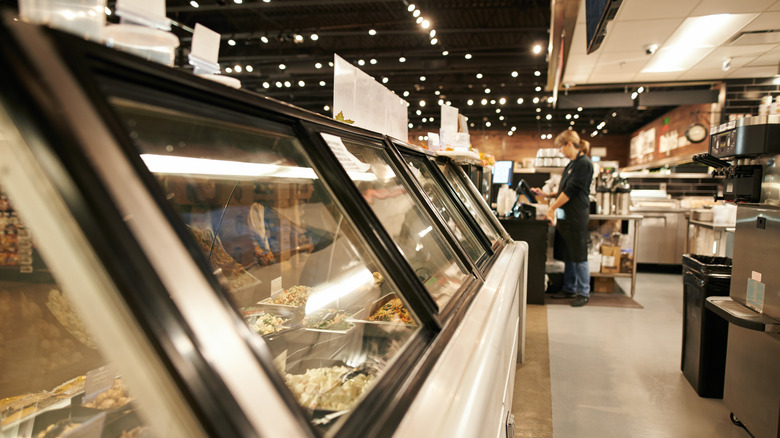Signs You Should Avoid Your Grocery Store's Hot Bar
While probably safer than Pete Davidson buying sushi at LaGuardia Airport, your local grocery store's hot food bar can still be a petri dish of bacteria and germs you don't want to bring home to your family. While the food looks and smells so appealing, especially when we are hungry during lunch or dinner time — not to mention we all need the occasional night off from cooking — there are some warning signs to look out for indicating the food may be unsafe.
The Centers for Disease Control (CDC) estimates that 48 million people in the United States get sick yearly from foodborne illnesses such as Salmonella, Listeria, and E. Coli. Of that, 128,000 are hospitalized, and 3,000 of the most vulnerable die (particularly infants, older people, and those with a weakened immune system). And since only a small fraction of people actually report incidences, the number is actually thought to be much higher.
While uncooked produce accounts for the most reported foodborne illnesses, meat (beef, game, and pork) and contaminated poultry contribute to the most deaths. Although some warning signs are more challenging to spot than others, consumers eating from a deli or grocery store hot bar should be mindful of a few things: how the food is maintained, how long it has been sitting out, what temperature it is being held at, the store's environment, and the staff's personal hygiene.
Pay attention to the holding temperatures
According to the U.S. Food and Drug Administration (USDA), improperly held food is the number one cause of foodborne illnesses. Hot buffet items, such as chicken tenders, pork chops, or baked fish should be stored in chafing dishes, slow cookers, or warming trays at a minimum temperature of 140 degrees Fahrenheit. Cold items like cut fruit and salads should be kept below 40 degrees Fahrenheit in nesting bowls over ice.
In addition, all buffet food, regardless of the holding temperatures, should be discarded after two hours. And any food left at room temperature in the "danger zone" (between 40 and 140 degrees Fahrenheit) for two hours, where bacteria can multiply rapidly, should be thrown away. Harmful bacteria is not easily detected, so err on the side of caution and avoid anything that looks or smells bad. It's certainly better to be safe than sorry in this case.
Although accidents happen at even the most well-run grocery stores, your odds are safer if you stick to reputable, busy establishments where the food is replenished often. The high turnover rate indicates the food is fresher, and the crowds, while irritating at rush hour, are a good sign that people aren't getting sick. Avoid late-night hot bar visits since that increases the likelihood of the food sitting there for hours.
Examine the store's environment and staff
Another important thing to take notice before loading up at the hot food bar is the supermarket's environment and staff. Generally, if the store looks dirty, it's a red flag that food safety isn't a priority. Check if the bathroom is clean, the aisles are maintained, and surfaces are regularly sanitized.
Additionally, ensure the food bar has a sneeze guard to prevent airborne germs from coughs and sneezes from spraying the food. A small amount of bacteria can proliferate, especially if the food isn't kept at the proper temperature.Each dish should have a dedicated serving utensil to prevent cross-contamination, whether it's a tong, slotted spoon, or spatula. If you notice that customers use the same utensil to serve multiple dishes or if the utensils look dirty, avoid purchasing that food.
Finally, although unpleasant to discuss, a food worker's poor hygiene can also contaminate food in a few ways. Sick employees can spread germs to prepared foods by improperly washing their hands after using the bathroom. Cooks can cross-contaminate dishes by inadequately washing knives or cutting boards between handling different ingredients. And if employees have dirty aprons and don't regularly change their gloves, especially if they accidentally sneeze into their hands, that's a for sure sign to head somewhere else for your meal.



